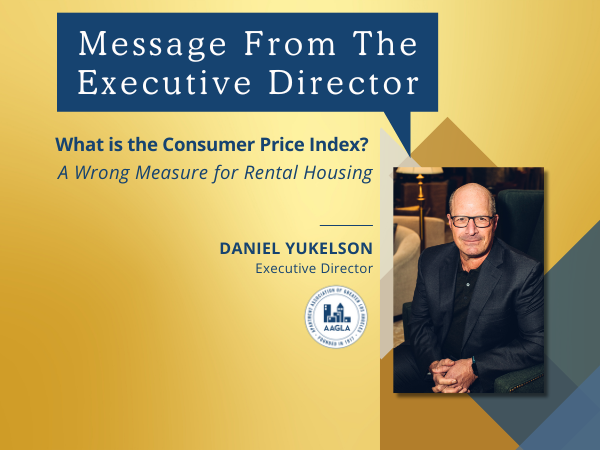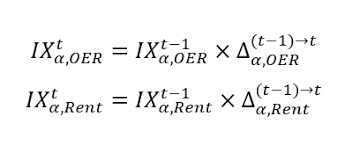What is the Consumer Price Index? A Wrong Measure for Rental Housing

What is the Consumer Price Index? A Wrong Measure for Rental Housing
Executive Director's Message
by Daniel Yukelson
The Consumer Price Index (CPI) measures the average change over time in prices paid by urban consumers for a “market basket” of consumer goods and services. The CPI is used for tracking inflation and deflation by comparing the cost of the “basket” in a current period to the cost of the same “basket” in an earlier base period. The CPI was developed by the U.S. Bureau of Labor Statistics (BLS), it is a key economic indicator used to adjust other economic measurements for price changes, such as allowable annual rent increases.
Many states and local jurisdictions require the use of a CPI measurement for a variety of purposes, including the escalation of contract rents. The CPI, however, is designed to measure the change over time in the cost of living of the “statistically average” consumer household in the United States. This means that the categories of items or “market basket” included in the CPI measurement are selected to represent items that the average American consumers purchase based on the BLS’ Consumer Expenditure survey. There are currently 243 basic item categories included in the estimation of the “all items” category of the CPI.
Rent-controlled jurisdictions across California, including the State of California under Assembly Bill 1482, use some form of CPI measurement to determine allowable, annual rent increases. Calculations range from CPI plus a specified percentage to CPI itself to CPI times some factor, such as “times 75%” per Pasadena’s Measure H. Some jurisdictions, such as Los Angeles County for its unincorporated areas, utilize 60% of CPI measurement to limit annual rent increases but allow a 1% or 2% additional increase for small owners or luxury units, respectively. Even worse, one proposal floated by Los Angeles City Councilmember Blumenfeld seeks to strip out a single component of measurement from the CPI, the measurement of “shelter” costs, which would drastically reduce CPI and the allowable rent increases each year.
Councilmember Blumenfeld’s logic for removing the “shelter” component of CPI is completely flawed. As has always been known, the shelter component of CPI that tracks rent and insurance is rough justice to reflect rental costs because rental pricing is presumed to reflect the costs necessary to provide housing. Despite this, cities like Los Angeles have commissioned a report that argues the shelter component of CPI is somehow “double-dipping” and, for that reason, should be stripped out of the CPI used to dictate maximum rent increases. It has been argued that rent is increased to increase profit and not just to cover increased costs – it is like a “because we can” argument. Also, as rent supposedly entails profit, it is compounded each year as is reflected in new rental rates that are typically higher. However, the counter to the argument to this is that there’s nowhere else other than the shelter component where all the costs of providing housing have been reflected in the CPI, including mortgage interest (which is one of the largest costs for those that have a mortgage) and property taxes, maintenance, and capital improvement costs.
However, as you will read, no matter how you slice and dice it, the CPI measurement does not include many components of costs incurred by providers of rental housing. Therefore, the use of CPI is not a fair measurement of housing provider costs and does not give us accurate measurements for setting annual increases, which is why so many housing providers are struggling to get by.
CPI Does Not Capture Costs of Providing Housing Services – “Rental Equivalent Approach”
The measurement of CPI does not capture mortgages and related fees or property tax because of the use of the “rental equivalence approach” to measuring shelter inflation for owners. The rental equivalence approach used in the measurement of CPI factors in the cost of housing services for homeowners by estimating the implicit rent they would pay for their homes on the open market. This method uses market rents for a sample of renter-occupied units, adjusted for physical and locational characteristics, to impute a change in housing costs for owner-occupied units. According to the BLS, this measurement is a widely supported, theoretically grounded method that reflects the economic value of the shelter services homeowners derive from their homes.
Since the BLS’ measurement objective of the CPI focuses on consumption and not on investment, the CPI seeks to measure the value of the shelter services provided by a dwelling and not the value of the dwelling itself. Other things like business licenses are out of scope of CPI measurement because they are not purchased by consumer households. Conceptually, any item that might be purchased by consumer households will be within the scope of the CPI. Those items which are purchased exclusively by businesses will not be in scope for CPI but may be included in the Producer Price Index (PPI).
Some cost categories necessary for providing rental housing services are included in the measurement of CPI, including:
- Energy Services, Including Electricity, Gas Service, Water and Sewer, and Trash Collection.
- Tenants and Household Insurance
- Legal Services
- Financial Services, Including Accounting
- Gardening and Lawn care Services
- Tools, Hardware, and Supplies
- Repair of Household Items, Including Various Home Repair Categories Such as Appliance Repair, Reupholstery, Window Repair, Plumbing, Electrical, HVAC, and Painting
CPI is an overall average of a “basket” of cost components measured against a previous average and calculated at a massive macro level. As a result, CPI could never account for any “micro level” major cost increases experienced by individual property owners who have seen the doubling or even tripling of a property insurance bill or have spent tens of thousands of dollars to address a situation with a “bad actor” tenant who is being evicted. When CPI merely dolls out 2% to 4% allowable rent increases, or sometimes even less, for individual property owners taking on a major cost “hit,” there is no way to ever catch up.
As the use of a CPI measurement by strict rent control regimes has been proven time and again, property owners who have in place long-term tenants quickly fall behind the market. The lack of housing supply created by the strict rent control regimes and the consistent trends of rental housing costs that are far outpacing CPI (inflation), causes asking rents to far outpace the CPI or percentage of CPI-based annual increases that rental property owners are being allowed. If we want to get to a truly representative index of costs for rental housing, we will have to conduct a specific cost study.
Unfortunately, our elected officials, who very often lack basic economic and business knowledge, could never understand this or even begin to explain CPI. Unfortunately, we rental housing providers will never be able to get an alternative to CPI unless the BLS were to agree to calculate a “Rental Housing Inflation Index” or something to that effect for us. Perhaps that could happen, but probably not in my lifetime…and even if there were such a calculation made, chances are our elected officials would never bother adopting it for setting annual rent increases.
The best advice I can possibly give you here is to never miss an opportunity to increase rent…that’s right, make increasing rent a regular, once-a-year activity without fail. The other thing you can do is “pray for the vacancy decontrol G-d” and that your long-term tenants move on so you can get back to market rent.

About the Apartment Association of Greater Los Angeles (AAGLA): Serving rental housing providers throughout Southern California since 1917, AAGLA is a leading trade association and government advocate. With over 10,000 members representing more than 350,000 rental units, our community includes rental property owners, managers, developers, real estate professionals, and trusted vendors. AAGLA also offers comprehensive member-exclusive education and training, including weekly webinars, in-person events, Lunch & Learn sessions, and Certificate programs covering legal updates, landlord-tenant laws, insurance, and more.
